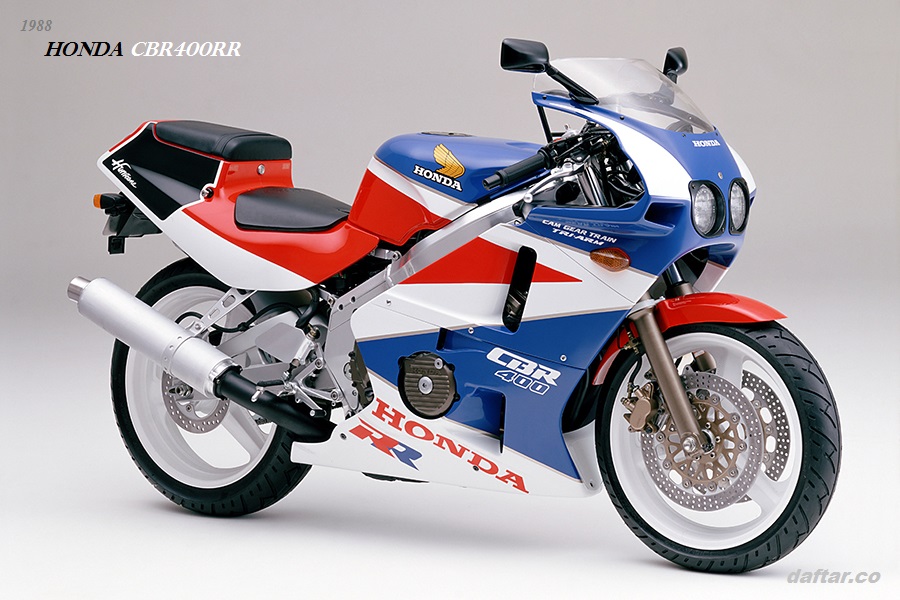1988 Honda CBR400RR Overview, Specs and Photos Gallery | Classic Super Sports Street Racing Motorcycle
After the successful of the predessor “CBR400R 1986“, Honda released the newer super sports bike “Honda CBR400RR” on January 19, 1988 that looks more sporty and racing oriented. It adopts advanced equipment such as a new fairing that combines excellent aerodynamic characteristics and a powerful form in the popular CBR series, front and rear wheel radial tires and powered by a water-cooled, 4-stroke, DOHC, in-line 4-cylinder 400cc engine that uses a cam gear train (a method of driving the camshaft with gears) mechanism.
 |
| Photo of 1988 Honda CBR400RR with new fairing, double seater, aluminium frame. |
1988 Honda CBR400RR Engine Overview
This Honda CBR400RR makes full use of the 4-cycle engine technology that Honda has cultivated over many years, and in addition to the light and smooth output characteristics that are characteristic of in-line 4-cylinder engines, it has a quick and powerful responsiveness in the middle and low speed range. Is even higher. Moreover, the basic skeleton from the frame to the swing arm to the wheels is all made of aluminum, and the aluminum muffler (silencer) is adopted for the first time as a mass-produced 4-stroke model. It is a super sports bike that combines strength and high quality.
Newly designed cylinder head, straightened intake port, direct push valve system without rocker arm, thin shaft (3.8 mm), large diameter (intake valve 22 mm/exhaust valve 19.5 mm) valve, etc. Achieves high combustion efficiency at the same time as reducing friction loss in the valve train. In addition, a large diameter (32.5 mm) quadruple carburetor and a new collective exhaust pipe are combined with a lightweight aluminum muffler (silencer) with a new structure to further improve intake and exhaust efficiency, especially in the middle and low speed range. It is designed to demonstrate the quick and powerful responsiveness of.
1988 Honda CBR400RR Frame & Suspension
The lightweight and highly rigid aluminum twin-tube frame, which has Honda’s unique “eye-shaped” cross-sectional structure, has a slimmer shape and contributes to ensuring a comfortable riding posture. For the front and rear wheels, a newly designed aluminum hollow 3-spoke cast wheel is combined with wide flat radial tires (front 120/60 R17, rear 150/60 R18). In order to take advantage of the characteristics of these frames and tires, we have newly developed a triangular swing arm (tri-arm) that has both slimness and high rigidity. Combined with the front and rear suspensions that demonstrate excellent road surface tracking, you can enjoy agile and nimble maneuverability.
1988 Honda CBR400RR Specifications
The manufacture’s standar specs of Honda CBR400RR 1987/88:
| Model | NC23 | |
| Overall length (m) | 2.020 | |
| Overall width (m) | 0.690 | |
| Overall height (m) | 1.110 | |
| Wheelbase (m) | 1.370 | |
| Minimum ground clearance (m) | 0.120 | |
| Seat height (m) | 0.765 | |
| Vehicle weight (kg) | 179 | |
| Dry weight (kg) | 162 | |
| Riding capacity (persons) | 2 | |
| Fuel efficiency (km/L) Constant driving test value | 38.1 (60km/h) | |
| Minimum turning radius (m) | 3.0 | |
| engine type | NC23E (water-cooled, 4-cycle, DOHC, 4-valve, in-line 4-cylinder) | |
| Total displacement (cm3) | 399 | |
| Inner diameter x stroke (mm) | 55.0 × 42.0 | |
| compression ratio | 11.3 | |
| Maximum output (PS/rpm) | 59.0/12,500 | |
| Maximum torque (kg-m/rpm) | 4.0/10,000 | |
| Carburetor model | VG04 | |
| Starting method | Self-style | |
| Ignition method | Full transistor | |
| Lubrication method | Pumped splash combination type | |
| Lubricating oil capacity (L) | 3.5 | |
| Fuel tank capacity (L) | 15 | |
| clutch type | Wet multi-plate | |
| transmission type | Always meshing 6-stage return | |
| Gear ratio | 1st speed | 3.307 |
| 2nd speed | 2.352 | |
| 3rd speed | 1.875 | |
| 4th speed | 1.590 | |
| 5th speed | 1.434 | |
| 6th speed | 1.280 | |
| Reduction ratio (1st/2nd) | 2.181/2.800 | |
| Caster (degree) | 25° 15′ | |
| Trail (mm) | 95 | |
| tire size | Front | 120/60 R17 55H |
| Rear | 150/60 R18 67H | |
| Brake type | Front | Hydraulic double disc |
| Rear | Hydraulic disc | |
| Suspension method | Front | Telescopic |
| Rear | Swing arm (tri-arm) | |
| frame format | diamond | |
1988 Honda CBR400RR Price
1988 Sales plan (domestic/annual) 16,000 units.
National standard cash price in Japan at that time (year of 1988): 699,000 yen. (Hokkaido/Okinawa is 9,000 yen higher, excluding some other remote islands).
Other Main Features & Equipments of 1988 Honda CBR400RR
- By adopting a water-cooled oil cooler that does not require an oil pump, both reduction of friction loss and weight reduction are achieved while improving cooling performance.
- The speedometer and gearbox have been changed from the front wheels to the rear of the engine to reduce unsprung weight and improve the rigidity around the wheels.
- The front wheels are equipped with large diameter (296mm) floating double disc brakes that give a good brake feeling.
- For the first time on the market, a retractable pillion step that can be used as a side grip or a loading hook when storing is adopted.
- A small case equivalent to 4 liters is set at the bottom of the rear seat. In addition, it is equipped with two helmet holders to improve convenience for touring.
- Adopts a step with a good operation feeling and a coaxial change pedal & brake pedal (made by duralumin).
- Insist on individuality with dynamic coloring and innovatively designed dual headlights and tail lights.